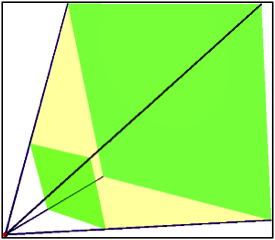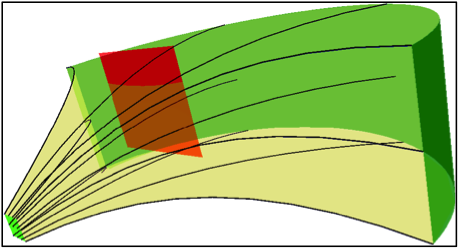 |
|
Robert P. Kelso Sr. from Louisiana Tech University defines distortion in perspective projection as the difference between normal vision and the emulation of normal vision by graphics of photography. He concludes that there is no remedy available to correct for the intrinsic distortion in perspective projection. Therefore, all standard, perspective projection images are necessarily distorted.
Nonlinear projection has been used widely in art beginning with cave art and continuing until the present day. It is a current area of research in computer graphics and provides a meeting place between science and art. In this paper, I begin by examining several cases of how and when artists choose to use nonlinear projection as opposed to perspective projection in their creation.
Projection is an interesting meeting point between art and science. The scientific approach to projection is to view it as the mathematical reduction of dimension and organization of the reduced dimension’s space. From here formulae, geometries, and spaces are theorized and derived. Artistically projection is a means of organizing space, relationships between objects, and the observer’s presence in an image.
But let’s try to analyze some different kind of non-linear projections, starting with the description that David Hockney gives. He examines a variety of evidence that leads him to conclude that many artists used concave mirrors and later lenses to construct images from the early fifteenth century and onward. While these primitive lenses would allow artists to paint from a moving image in bright light conditions a key limitation was the small size of the projected images. In general these images could be no larger than 30 cm across.
As a consequence if an artist wished to create a larger image the artists would either have to try to repaint the image larger without aid of projection, or project the scene a piece at a time and then blend the pieces together into a unified whole. It seems quite clear that this type of non-linear projection performed by artists is the inspiration for the multi-camera projection systems.
Ernest Watson is instead interested in what he defines as Creative Perspective, or techniques used by illustrators to create perspective projections as well as to modify them for various purposes. He calls such modified projections, creative perspective and notes that an artist who uses “…perspective creatively [can] bend it to his uses rather than be limited always to strict conformity”.
 These manipulations are used to allow the viewer to see structures that should be hidden, changing the scene (usually by manipulating vanishing points) to improve its overall composition, allow the viewpoint to shift to more closely recreate human visual experience, and lastly make the illustrations more dramatic and interesting. Manipulating the projection allows illustrators to present objects in precisely away that they feel will have the desired impact. These manipulations are used to allow the viewer to see structures that should be hidden, changing the scene (usually by manipulating vanishing points) to improve its overall composition, allow the viewpoint to shift to more closely recreate human visual experience, and lastly make the illustrations more dramatic and interesting. Manipulating the projection allows illustrators to present objects in precisely away that they feel will have the desired impact.
Finally I want to give a fast overall of the research that computer scientists Brosz, Carpendale, Samavati, Wang and Dunning are developing around what they define as flexible projections in computer graphic and in art.
Figure 7, A perspective projection’s viewing volume. The viewing volume is bounded by the near and far planes (green) and the sides of the frustum (yellow). From Brosz et all, Art and Non-linear Projection, 2008.
 Flexible Projection is unusual as it approaches projection, a rendering technique, with modeling tools. The primary concept of Flexible Projection is in defining the viewing volume (the 3D volume that will appear in the 2D image) as a parametric volume Q (u;v;t). This volume is defined so that the parameters u;v; and correspond to the width, height, and depth positions that will result in the projected image. This volume can be stretched and reshaped to affect the projection and consequently the image. Flexible Projection is unusual as it approaches projection, a rendering technique, with modeling tools. The primary concept of Flexible Projection is in defining the viewing volume (the 3D volume that will appear in the 2D image) as a parametric volume Q (u;v;t). This volume is defined so that the parameters u;v; and correspond to the width, height, and depth positions that will result in the projected image. This volume can be stretched and reshaped to affect the projection and consequently the image.
Figure 8, The viewing volume of a Flexible Projection. The volume is shown in yellow, the green surfaces are the near and far surfaces, the red surface controls the curviness of the volume, and the lines shown projectors within the volume. From Brosz et all, Art and Non-linear Projection, 2008.
What they are saying is that in a standard perspective projection the volumes are views by an eye position near surface and far surface as in Figure 7. In the flexible projection they introduce a variation that can be obtained by altering the interpolation between surfaces. For instance, by adding surface(s) between the near and far surfaces we can use Bezier curves to interpolate between the surfaces obtaining greater control over the volume as is shown in Figure 8.
Using a flexible projection in art can be useful in applying these distortions for two reasons. The first is that the distortion could be adjusted to affect different depths of the scene differently; as a result the background of the scene could feature a different sort of distortion than the foreground. Another interesting aspect is that the flexible projections can be animated by moving the projection surfaces over time. This adds an extra impression of change to the projection.
|

